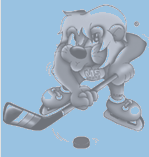HISTORY
Hockey is, of course, doing very well in Scandinavia, but Denmark for a long time seemed an exception, unlike its northern neighbours it didn’t seem to be doing anything of note. Only at the World Championship in Finland in 2003 did Team Denmark re-introduce itself to the elite world group (for only the second time in history). But once there, from the point of view of form and overall success they even surpassed Norway. The team playing in the red and white may not yet be as good as the Finns or Swedes – but they know that their goal is to learn from the successes of those two teams.
The first signs of Danish hockey date from the year 1920 on the Jutland peninsula. But the sport did not exactly settle down on a bed of roses in this small seaside nation – the natural conditions there were not in favour of winter sports, more popular sports being for example football, handball, and cycling.
Yet hockey still managed to grow. In the year 1941, a club in Rungsted built the first hockey stadium in Denmark, in 1947 Herning followed suit, and subsequently in other towns too stadiums began to spring up. 1949 in Stockholm, was the first time the Danes tried to measure their power against the world’s best at the World Championship. It may not have been a long trip to Sweden but it seemed the Danish team didn’t save up a lot of strength on the way – as they lost to Canada by a score of 47-0 (still a World Championship record), and then they dropped their next game as well, this time to Austria 25-1. So with an unbelievable goal differential of 72-1 from two games they finished in last place.
The same year however, on 27 November 1949, saw the founding of the Danish Hockey Federation (Danmarks Ishockey Union – DIU), which took over the organization of the domestic league. Currently only twenty teams are playing in the league, and things are constantly improving. In the Danish first division ten teams take part (the stocks of some teams are even available on the stock exchange), all players are professional, and the interest of fans is also on the rise. Three years ago the average attendance at a Codan League game was 1 200 and at play-off games 2 300. But this past season, twice that amount of fans could be seen at some of the games.
In their more recent history too, the Danes were not successful for a long stretch of time, the players refused to represent their country for various different reasons which led to numerous conflicts, at least until Swedish coach Jim Brithen took over and put everything in order. In the year 2002 in the Hungarian cities Szekesfehervar and Dunaujvaros, the Danes advanced to World Championship Group A. In the fight to be among the elite the Danish defeated all five of their opponents – Great Britain, Romaina, China, Norway, and Hungary. They won the group with a score of 40-10 and with the maximum number of points. Peter Hirsh, who had been playing for Sweden’s MoDo shone in goal in Hungary.
At the World Championship in Finland in 2003, the Danish called up six players from MoDo, Malmo, and Leksand, and the results of this were obvious to see – once again the Danish introduced themselves to the overseas teams but with a very different result – they shocked the Americans by beating them 5-2. The Danes proved this wasn’t a coincidence in the second round of the tournament, where they skated to a historic tie with Canada, the team which eventually went on to win the gold medal – and this was the only point the Canadians dropped in the entire tournament. The Danish players did not figure in the individual statistics categories at last year’s World Championship, but for the first year back among the world’s top teams, Denmark did itself proud indeed.

WEB SITE
www.ishockey.dk
STATS
You can find the results and the calendar of 2003/04 season HERE
MEDALS
Team Denmark has never won a medal at either the World Championship or the Olympic Games.








